Our view at Stack - Pipedrive is a robust CRM platform, offering automation, contact data collection, webhooks, AI-powered sales assistant, email communications, email marketing, and customisable sales pipeline workflows.
Effective performance management ensures your team knows their roles and has the support to achieve personal and business goals.
As a manager, achieving this can unlock unparalleled efficiency, higher employee engagement and a better company culture.
In this article, you’ll learn what performance management is, how it benefits your business and four steps to creating an effective performance management system.
What is performance management?
Performance management is an ongoing process that ensures employees meet their goals and contribute to the company’s success. It involves setting clear performance expectations, providing continuous feedback and encouraging employee development.
At its core, performance management involves:
-
Setting specific, measurable objectives that align with the company’s strategic goals
-
Defining employees’ roles, responsibilities and performance standards
-
Holding regular check-ins and feedback sessions to monitor progress, address challenges and celebrate achievements
Effective performance management is more than just an annual review. Performance appraisals are a part of the process, but they should complement ongoing management rather than being the only evaluation method.
A well-organized business may even plan informal performance reviews daily. A structured performance review cadence, including informal reviews, ensures continuous feedback and strategic alignment across all management levels.
For instance, in McKinsey’s review cadence below, shift-level dialogues act as a checkpoint to review issues specific to each shift, while monthly and quarterly reviews evaluate long-term trends.
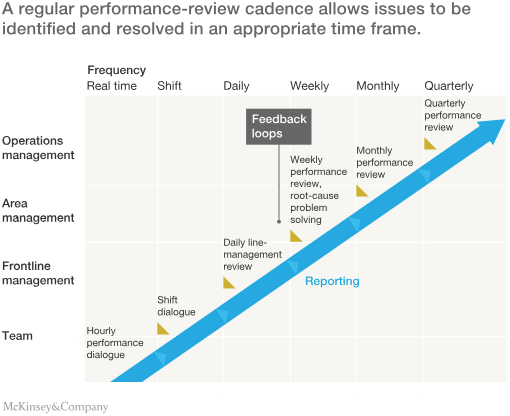
This cadence may work for a large company, like Toyota, with its Andon systems (a visual signal where action is needed) and Genba walks (walking the floor to spot improvement opportunities). However, a smaller company can also benefit from structured, regular feedback.
Productivity software Basecamp is well-known for breaking traditions in working culture, but it still handles performance management with formal and informal reviews.
According to one of Basecamp’s designers, Shaun Hildner:
Performance management might not look identical in every business. Ultimately, it’s about creating a supportive ecosystem where the company and its employees thrive.
In order to ensure this success continues as the company grows or the market wobbles, you need a plan. Let’s explore some other ways performance management supports the business.
Recommended reading

How to track, measure and improve your team’s sales performance
How performance management improves business outcomes
When executed well, performance management can boost productivity, enhance engagement and promote a healthy company culture.
Let’s take a closer look at the benefits:
-
Enhanced financial performance. Companies with effective performance management programs are 1.5 times more likely to outcompete competitors. Aligning employee objectives with company goals improves business outcomes, helping companies gain a competitive edge in the market.
-
Increased productivity. Regular feedback and clear goal setting help employees focus on high-impact tasks, improving efficiency. Companies with strong performance management are 1.25 times more likely to see increased productivity.
-
Better engagement and goal alignment. A Betterworks study found that 21% of employees set annual goals but never revisit them, while 16% don’t set goals at all. Effective management solves this problem by motivating employees to achieve their yearly targets.
-
Stronger organizational culture. Transparent performance management systems create a culture of accountability and continuous improvement. They promote open collaboration between managers and employees, leading to more cohesive teams.
-
Increased employee retention. Rewarding performance makes employees feel valued. They’re more likely to stay with the company when they see a clear path for growth and receive recognition for their successes.
Recommended reading

Personnel management: definition, importance and emerging trends
4 steps to effective performance management
The performance management process has four steps: planning, monitoring, developing and rewarding.
Let’s dive into these steps to see how they contribute to a well-rounded performance management cycle.
1. Planning and setting objectives
Planning is the first step in performance management. In this phase, managers and employees work together to set attainable objectives that align with the company’s aims.
This step is where you plot out a roadmap to successfully meet your goals. You need to know where you’re going to get there.
For example, in sales management, a planning session might involve:
The planning stage should also involve developing timelines to implement these targets. This way, employees have a guideline for their day-to-day activities, giving them a clear sense of direction.
Key takeaway: You can’t measure employee performance if they don’t know where they’re going or why. Setting goals and objectives helps employees understand what to do and why.
2. Monitoring
Once plans are in place, continuous performance management tracks progress and makes necessary adjustments. Managers review performance data and hold regular check-ins to give employees constructive feedback.
The monitoring step is what most people think of when they think of performance management because this is where the check-ins and meetings take place. However, as you can see from the steps in this guide, there’s more to it than just setting up a meeting and asking the team members what they’ve accomplished.
Effective monitoring helps leaders identify and address problems early to prevent them from becoming obstacles to meeting objectives.
Knowing there are regular check-ins also motivates employees to meet their goals. Think of it as tuning up an engine to keep it running smoothly.
Here are a few ways to monitor performance:
-
Perform regular check-ins. Schedule one-on-one or team meetings to review employee progress. Depending on your needs, these can be weekly, bi-weekly or monthly. Use these meetings to discuss what’s working well, address challenges and recalibrate goals.
-
Review performance data. Analyze real-time data from your CRM system to keep a pulse on team performance. Focus on key metrics like lead conversion rates, sales cycle length and deal closing rates. Compare current metrics to your targets and identify areas that require performance improvement.
-
Communicate transparently. Keep lines of communication open with your team, encouraging them to share any concerns. Use data visualizations and reports during meetings to clearly illustrate trends and performance metrics.
If performance data shows a deviation from targets, take immediate action to address the issue. Adjust action plans and strategies as needed to keep the team on track.
You could also provide additional training or resources to help team members overcome challenges – but more on this in the next section.
Key takeaway: Check in informally often and schedule regular data reviews (weekly, monthly or quarterly, depending on your needs) to stay on track toward targets. Importantly, share information with your people so they know if their efforts are working.
3. Developing
In the development phase, managers focus on building employee skills and knowledge. The goal is to work on skill gaps through personalized development plans.
First, use the performance data and feedback from the monitoring phase to pinpoint skills and knowledge areas that need development. Discuss these with employees to understand their career aspirations and align development plans with company and individual goals.
The next step is to create personalized plans for individual employees. Work with each employee to create plans that address their needs and goals.
Outline clear objectives, required resources and timelines for achieving these goals. Make the plans flexible enough to adapt to changes in the employee’s role or business environment.
These development initiatives might include:
-
Mentorship programs where experienced team members can guide less experienced colleagues
-
On-the-job training sessions for employees to gain hands-on experience and apply new competencies
-
Career coaching to help employees navigate their professional growth and set long-term career goals
For instance, a sales manager might arrange training for team members to learn new methodologies and soft skills. The key is to create opportunities for continuous learning, helping employees achieve their targets and preparing them for more responsibilities.
Key takeaway: The monitoring stage is bound to catch obstacles, so the next step is to find a way over them. Leaders can fix knowledge and skills gaps with training and mentorship.
4. Rewarding
Rewarding is the final step. Here, managers recognize and reward employees for their achievements and contributions. It’s the cherry on top that validates all of your reps’ efforts.
Effective reward systems can include bonuses, commissions or non-monetary incentives like public employee recognition, additional vacation days or professional development opportunities.
For example, in a sales team, top performers might receive quarterly bonuses based on their performance against sales quotas.
Appropriate rewards are essential for maintaining motivation and reinforcing effective behaviors and results. A well-structured reward system also boosts morale and encourages a high-performance culture where employees feel valued. It’s a win-win for everyone.
Key takeaway: Performance reviews can be nerve-wracking for many people. Using them as opportunities to improve and reward employees can help make monitoring less intimidating and more encouraging.
4 best practices for performance management
Using proven performance management strategies can help employees feel supported and motivated to meet their goals.
Here are four best practices that will elevate your performance management approach.
1. Set SMART goals and strong action plans
Setting the right type of goals is important to improve employee performance and business outcomes. SMART goals are an effective way to do this because they’re:
-
Specific. Clearly define what the employee needs to accomplish. A performance management example might be “Increase lead conversion rates by 10%”. The goal is precise and clear so that employees know what you expect from them.
-
Measurable. Ensure you can track and measure the goal. For example, “Track the number of leads converted into paying customers monthly using the CRM system.” It allows you to monitor progress accurately and assess if the employee meets the goal.
-
Achievable. Set realistic targets based on available resources and capabilities. Assess historical data and market conditions to ensure the 10% increase is attainable. For example, “Current conversion rates and available resources suggest a 10% increase is realistic with additional sales training.”
-
Relevant. Align the goal with broader business objectives. In our example, increasing conversion rates by 10% might contribute to the larger business goal of boosting monthly sales revenue by 20%.
-
Time-bound. Establish a clear deadline, like “within the next quarter.” Being time-bound sets a specific timeframe for achieving the goal, providing a sense of urgency and prioritizing efforts.
With SMART goals in place, you need to outline the exact steps you’ll take to achieve them. Divide larger objectives into smaller, manageable tasks. For example, if the goal is to increase lead conversions, a key task would be to review follow-up processes.
Identify who’s responsible for each task, then determine which tasks are most critical and tackle them first. To keep momentum, use a mix of short-term and long-term deadlines.
Finally, build some flexibility to account for unpredictable problems and schedule periodic reviews to track progress and make adjustments.
Download Your Guide to Sales Performance Measurement
The must-read guide for any sales manager trying to track, forecast and minimize risk. Learn how to scale sales with data-backed decisions.
2. Choose the right performance management model
Choosing the right performance management model is crucial for aligning organizational goals with employee performance. We’ve touched on the general approach to performance management, but the specifics can vary.
Different performance management methodologies have benefits and downsides. Selecting the right model depends on your organizational needs and culture.
Here’s a look at three performance management models to help you decide which is the best fit:
|
360-degree feedback: Gather feedback from various sources, including peers, subordinates and supervisors, to give a well-rounded view of an employee’s performance. |
Benefits: Offers diverse perspectives and highlights strengths from multiple viewpoints. Downsides: Often time-consuming and has a potential for bias. |
|
Objectives and key results (OKRs): Set SMART objectives and define the measurable outcomes to monitor progress. |
Benefits: Has clear, achievable performance goals and promotes organizational objectives.
Downsides: It can be challenging to set effective OKRs. |
|
Balanced scorecard: Track performance across multiple perspectives – financial, customer, internal processes and learning and growth. |
Benefits: Gives a balanced view of performance and aligns daily activities with strategic objectives. Downsides: It can be complex and needs constant data collection and analysis to pull off effectively. |
Understanding the benefits and downsides of each performance management model will help you choose the one that best suits your culture, priorities and goals.
3. Facilitate upskilling opportunities
Professional development is a crucial part of a good performance management strategy. Creating opportunities for continuous learning allows employees to enhance their skills, stay motivated and contribute more to the company.
Here are some engaging ways to facilitate skill-building opportunities:
-
Schedule regular training sessions. Organize training programs for essential skills. In sales, this might include advanced sales techniques, customer relationship management or effective communication.
-
Encourage participation in industry events. Motivate employees to attend conferences, webinars or online courses to expand their knowledge and stay current with industry trends. These events provide fresh perspectives and networking opportunities that can guide professional growth.
-
Promote cross-functional projects. Working across different departments helps new employees understand other parts of the business. Hands-on exposure allows them to gain diverse experiences and develop a broader skill set.
-
Create a culture of continuous learning. Build an environment where teams value continuous learning. Set aside dedicated time for skills development or provide access to learning resources like e-books, online courses and training platforms.
-
Use specialized trainers. Hire specialized trainers to provide expertise in areas where employees need development. For example, in sales management, trainers can offer workshops on different techniques, such as negotiation skills or product knowledge.
While training costs can be a concern, consider the return on investment (ROI) by linking training to performance metrics like increased sales, improved customer satisfaction or enhanced productivity.
It’s also a good idea to use a mix of in-person and virtual training sessions to balance costs and accessibility. Virtual training can often be more cost-effective while still delivering high-quality content.
4. Use the right tools
Specific tools can help streamline performance management activities, including goal-setting, tracking, feedback and evaluations.
Here’s an overview of some of the best performance management software that can help you manage your employees:
-
CRM software. CRM systems like Pipedrive help sales teams track deals and manage sales funnels. Pipedrive provides sales teams with real-time insights and tracks key metrics to evaluate performance against targets. Sales managers can use this data to monitor performance and address issues.
-
Human resource management systems (HRMSs). HR software provides tools for tracking performance, managing HR processes and generating reports. They also feature goal-setting, performance review and continuous feedback mechanisms that assist with management.
-
OKR tools. Tools like Workboard and Weekdone provide real-time progress tracking, alignment dashboards and performance analytics. They also help you track and display results in visual progress charts.
-
Performance appraisal systems. Software like 15Five and Lattice are performance management tools that conduct check-ins, facilitate feedback and track goals. They also include features like surveys to gauge morale and find areas for improvement.
-
Learning management systems (LMSs). TalentLMS and Docebo are two examples of LMSs that support online training and development programs. You can add customizable courses, progress tracking and certifications to educate and train employees. For a budget alternative, consider creating your own in-depth knowledge base.
Using the right tools helps you create a seamless, data-driven performance management system that enhances productivity and engagement. The right tech stack can turn a good performance management strategy into a great one.
Recommended reading

How to use performance objectives to achieve business success
How to manage performance in Pipedrive
Sales managers and small business owners can leverage Pipedrive’s built-in features to effectively track employee and team performance.
Here’s how to manage how well your sales machine runs in Pipedrive.
Leverage dashboards
Use Pipedrive’s dashboards to display individual and team performance for daily monitoring.
Its customizable dashboards let you visualize key metrics like sales targets, conversion rates and deal progress in real time.
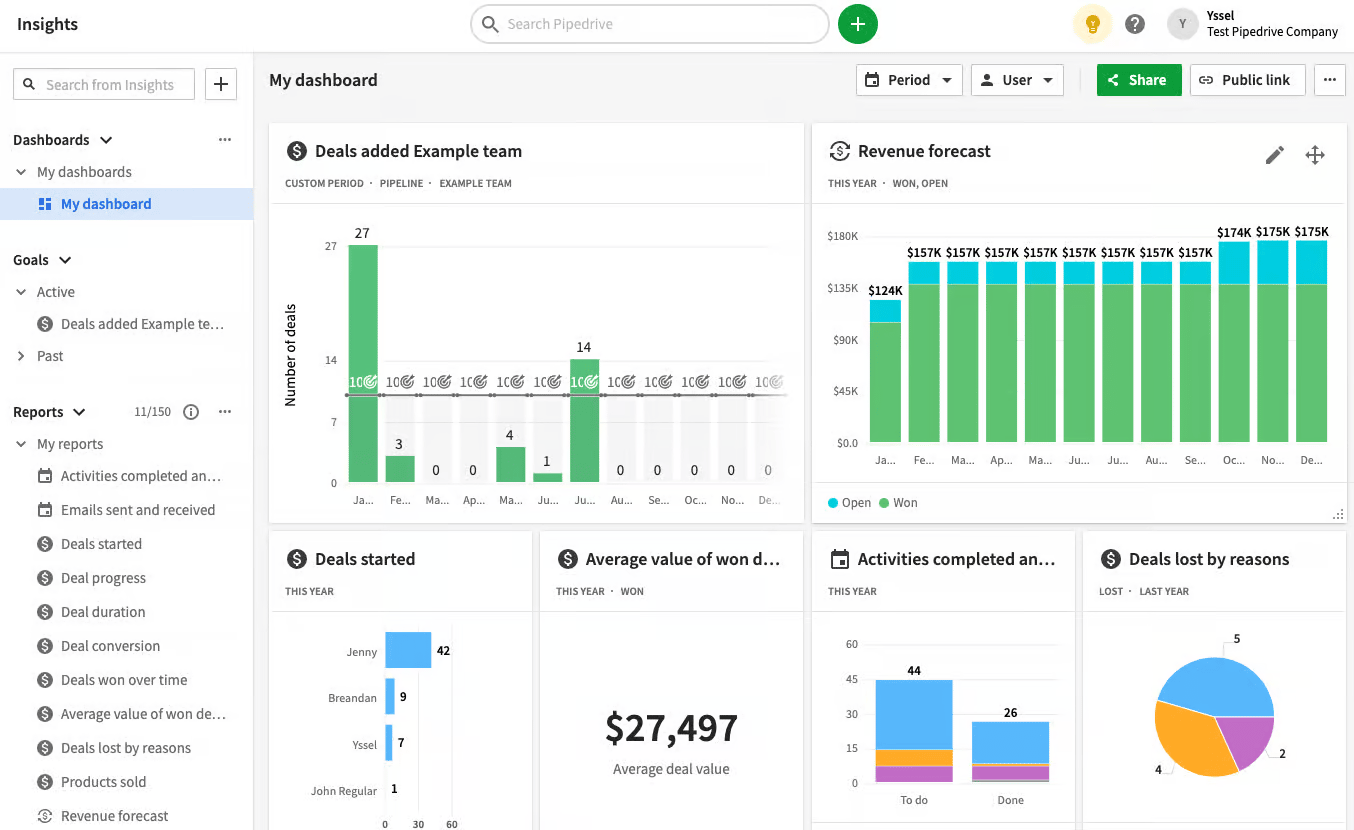
For individual insights, user-specific filters analyze each employee’s performance against set KPIs so you can identify high performers and those who need extra coaching.
For team performance, you can filter reports by teams to aggregate data and give an overview of productivity, allowing you to quickly identify areas for improvement and spot trends that might impact future performance.
Track activities
Pipedrive tracks key activities like calls, emails, meetings and tasks. You can monitor and review each employee’s activities and compare them against targets.
Using this information, you can determine if more follow-ups are needed, meeting schedules are too sparse or email communication needs to be ramped up.
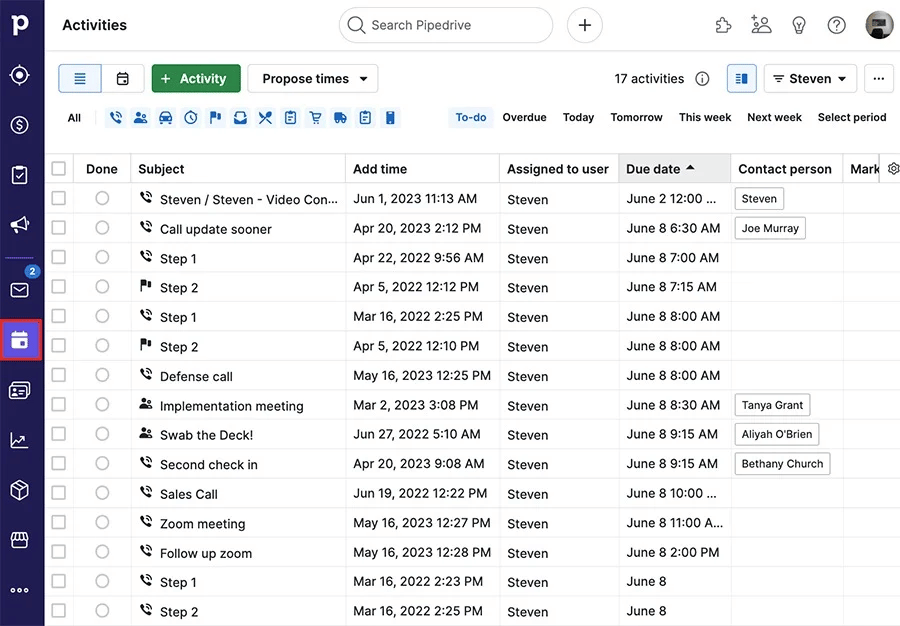
Pipedrive gives you full visibility of your team’s sales activities. Comparing these activities against targets means you can determine if adjustments are necessary and provide targeted feedback to reps.
Set goals for teams and individuals
You can also use Pipedrive to set custom goals for your sales reps, such as specific revenue targets or the number of closed deals. You can assign individual goals to representatives or set broader team goals.
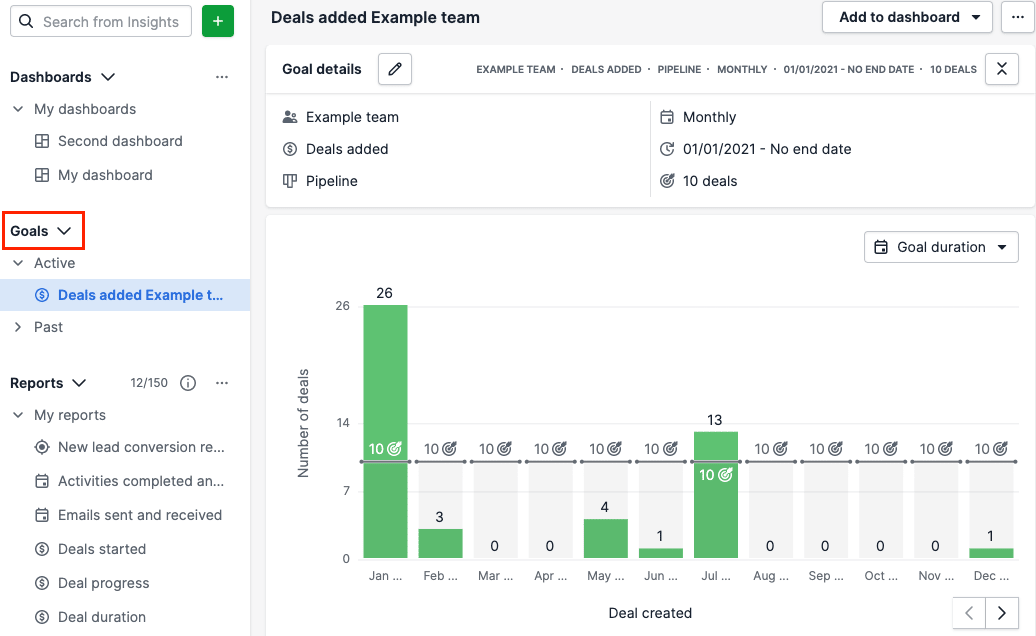
Once set, Pipedrive’s goals feature lets you track performance against these targets over daily, weekly and monthly periods. You’ll get real-time updates in customizable dashboards, making it easy to monitor progress.
Monitor progress with reports
Pipedrive offers several useful report types that give instant insights including deal status, deal performance and revenue tracking.
Deal status reports track the number of deals each team member has in different pipeline stages. They let you gauge how efficiently deals are progressing and whether or not improvements can be made.
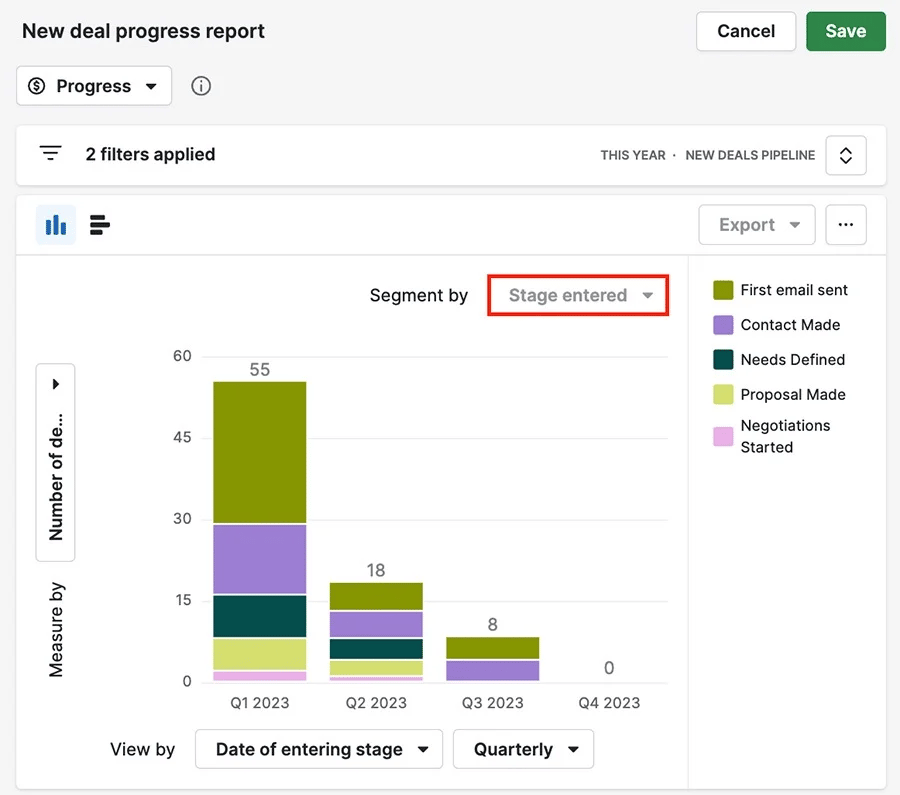
Pipedrive can also show deal performance reports. These reports show the number of deals each rep has won or lost, highlighting their closing rates.
Finally, revenue tracking reports monitor how much revenue each team member (or the team as a whole) brings in, giving a clear picture of financial performance.
Foster healthy competition with leaderboards
You can also set up custom dashboards to display as leaderboards to boost motivation and introduce healthy competition and transparency. Colorful charts let teams see who excels in deals won, revenue generated and activities completed.
To maximize this feature, you can set up a dashboard displaying sales or activity performance and adjust permissions to ensure it’s accessible to everyone.
You can also use Pipedrive’s many integrations, like Spinify or Pointagram, to motivate your sales team and increase performance.

Final thoughts
Effective performance management is the key to developing a high-achieving team. From planning clear goals to rewarding success, a structured approach ensures your team knows their roles, stays engaged and grows professionally.
Ready to elevate your team’s performance? Discover how Pipedrive can help streamline your performance management strategy.
If Pipedrive is of interest and you'd like more information, please do make contact or take a look in more detail here.
Credit: Original article published here.
